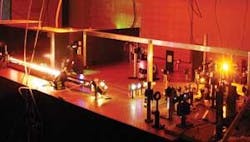
A new approach to nonlinear spectroscopy has shed some light on the electron coupling in a photosynthetic protein. The technique, dubbed angle-resolved-coherent (ARC) wave mixing, produces direct maps that elucidate the coupling of electrons to each other and to other molecules in the bacterial protein LH2.1
The strength of the method lies in the fact that whole spectra can be acquired with a single laser shot from an ultrabroadband source developed in collaboration with laser physicists at Imperial College London, and need no further post-processing to yield data on strong electron coupling (see figure). Ian Mercer of University College Dublin has been developing the approach for a number of years, and sees it as a sea change for nonlinear spectroscopists.
Like many four-wave-mixing techniques, the input beams are arranged in a “box” geometry, and conservation of momentum promises an output signal in a given direction. But ARC leverages the huge power of the laser source and uses a soft focus of the input beams–a few millimeters at the beam waists–to reduce divergence in the output. As a consequence, the nonlinear signal of interest is spread out spatially in the far field, with discrete angles dependent on the frequencies in the ultrabroad source. The result is a direct map of correlations between different energies in the nonlinear response, projected directly onto a detector, with a full data set in just one shot from a kilohertz source.
“All these nonlinear techniques are shooting lasers into a sample, it’s just a matter of how you do it,” says Mercer. “This is the first one that makes use of the angle of the output.” He notes that the ability to get such an easy and intimate look at the electron-transfer process has sparked the interest of a number of other researchers, and the group is already using the technique to look at electronic devices, in which the details of electron coupling and dynamics are paramount.
“There isn’t a conversation I’ve had that hasn’t resulted in someone saying, ‘well, let’s get a sample in there,’” he says.
Light pipe
The high single-shot signal-to-noise ratio from such softly focused lasers is due to the novel nature of the laser source the team used–delivering a full millijoule of energy in a spectral band spanning 750 to 880 nm.
Imperial’s John Tisch has been working toward attosecond sources for a number of years, and has improved on existing techniques to develop such ultrabroadband pulses at very high powers.
The group’s technique involve inducing self-phase modulation in a gas-filled hollow fiber to spectrally broaden 30 fs input pulses from a Ti:sapphire laser. The approach was so successful that the group was approached by Rutherford Appleton Laboratory (RAL; Didcot, England) to bring the few-cycle pulse capability to its Astra laser.
“We essentially have a coherent white-light source–you can imagine it as a box located after a short-pulse laser, which effectively makes the pulses even shorter,” Tisch says.
The approach broadens the bandwidth and shortens the pulse by as much as a factor of six. Such a hollow-fiber approach was first pioneered by Nisoli and colleagues in 1996.2 It has until recently been limited to low-power pulses. The earlier attempts suffered from power limitations almost purely because of the way the light entered the hollow fiber, Tisch says, making the output very sensitive to the pressure of the gas in the fiber.
“The problem was that the laser has to fight its way through gas before it gets to the capillary, so it can become defocused through, for example, plasma production,” he says. “We used some clever engineering and vacuum pumping so the system becomes much more robust to changes in the gas pressure.”
As a result, the bandwidth and pulse width can be tuned “on the fly” without changing the output waveform simply by changing the pressure of the gas in the fiber.3 Prior implementations of the approach require painstaking realignment and optimization of the system. The result is that the team gets a full watt of average power in a stream of 5 fs pulses at a kilohertz repetition rate–an attractive prospect for any number of users at RAL.
It would seem that the publication of the photosynthetic protein results has highlighted two potentially very popular threads that came together for the work: a novel spectroscopic method with unprecedented power to resolve electron dynamics, made possible with a laser source that spans the near-IR at comparatively enormous pulse energies.
REFERENCES
- Mercer et. al., Phys. Rev. Lett. 102(5) (2009).
- Nisoli et. al., Appl. Phys. Lett. 68, p. 2793 (1996).
- Robinson et. al., Appl. Phys. B 85, 525 (2006).
D. Jason Palmer | Freelance writer
D. Jason Palmer is a freelance writer based in Florence, Italy.